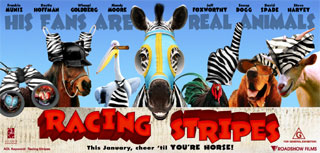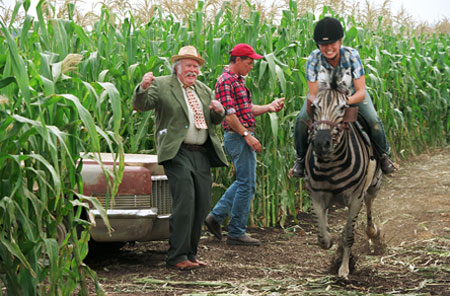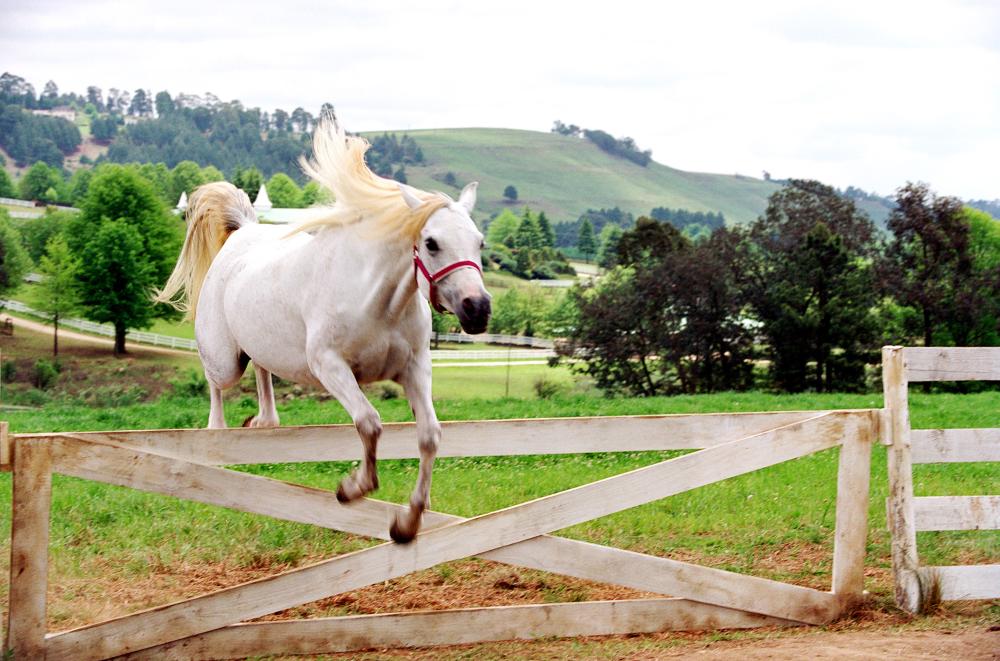
Racing stripes (Frederik Du Chau 2005) is an American sports comedy which centres on the glamourous and wealthy sport of horseracing in Kentucky. However the film does this through a comedic twist. The film has a bildungsroman performance narrative and follows the journey of a young girl and her unconventional mount Stripes, a zebra. After a baby zebra is left behind by a travelling circus Channing Walsh (Hayden Panettiere) and her father (Bruce Greenwood) raise the foal and train him into a race winning champion. He is accepted and nurtured by the Walsh family and their assortment of farm yard animals, which act like an encouraging yet dysfunctional family. The Walsh farm is a space where individuality is celebrated. However the stud farm on the other side of the fence does not share this accepting ideology. There the zebra’s otherness in the rural Kentucky setting and juxtaposed with the refined, elitist world of the stud farm is ridiculed by the animals and humans alike. Through the struggles of the human and animal lead characters, the film comments on the incompatible relationship between prejudice and individuality.
Racing Stripes joins many classic films in the American sports film genre such as Remember the Titans (Boaz Yakin 2000), Million Dollar Baby (Clint Eastwood 2004), the iconic Rocky (John G. Avildsen 1967) and even Seabiscuit (Gary Ross 2003) which similarly focuses on the horse racing industry. However Racing Stripes is a film which fits more into the hybridised genre of Sports Comedy cinema. The trait which is common throughout this genre is the main character’s struggle for sporting success even against the odds which are inevitably stacked against them, making their victory all the more glorious and exciting. One thing which makes Racing Stripes stand out and therefore makes it an interesting subject for analysis, is its use of two protagonists, one human and one animal. This is achieved as the human and animal worlds run parallel to each other. Though they are linked and follow the same linear, goal oriented narrative, the animal and human world stay separate. This is due to the fact that the animals have the ability to talk to each other yet cannot be understood by the humans. This gives their world an air of privacy and allows the animal world to function like a subplot. However that does not make the animal characters any less important. In fact, Stripes can be seen as an even more important character than Channing as he is central to the plot in both the human and animal worlds and essential for the success of the goal orientated narrative.

The scene in which this is most noticeable is when Stripes first sets eyes on the race track next door. The scene even opens with the rooster shouting “Good morning Walsh farm”. Instead of using the geographical location such as the town or city the rooster uses the farm’s name in his parody news bulletin. This use of the specific name of “Walsh Farm” signals it as different to the rest of its surroundings, a space which physically and ideologically defines itself only against what it is not. It is not the corporate and cold racetrack or stud farm and therefor sets up a distinct binary between the inclusive utopian space of the Walsh farm and the business oriented world of thoroughbred racing. The farm is also defined by the Walsh family name which immediately gives it a friendliness and personality. Andrew Charles Miller states that American Sports films all follow similar generic patters because they are built upon “An American utopia founded upon an athletically inflected American dream powered by a philosophy of self-determination and an ideology of a level playing field.”[1] In his essay Laying Down the Rules: The American Sports Film Genre From 1872 to 1960. This simple ideology can be seen in modern American sports films even today and it is this foundation which racing stripes owes its success to. The Walsh farm itself becomes a utopian and Eden like space for the orphan zebra who is effectively reborn into his new family. The Walsh farm in its strange mixed bag of characters creates a family like environment. This is as it forces the animals to work together, resulting in a space of equality, fairness and acceptance: the right environment for Stripes’ talent to grow. The American dream is subverted for a more modern audience and has a more innovative twist due to the two protagonists. Oxford English Dictionary online defines the American Dream as “The ideal that every citizen of the United States should have an equal opportunity to achieve success and prosperity through hard work, determination, and initiative.”[2] Stipes is an unusual character for the American dream narrative as he is a foreign animal and neither a citizen or an American. Channing, the other pursuer of the American dream is a female which is quite progressive as the American dream is traditionally something thought of as being an exclusively a male quest. The comedy element of the film’s hybridised genre allows the American dream to be achieved through the hard work of Nolan and Tucker when in reality it would be impossible for a zebra and amateur jockey to win the Kentucky derby against trained race horses. As Hayden Panettiere herself states in an interview “They’re very slow animals actually. Very slow. Unless you stick a lion behind them and even then they won’t even run in a straight line.”[3] The relative possibility of their victory is not questioned by the audience as it is the comedic genre which creates the film’s world in which this could believably happen.
This scene in which Stripes expresses his desire to become a race horse is also useful in analysing the significance and the boundary between the human and animal world. The scene moves from the world of the human in to the world of the animal and therefore, the subplot as Channing lets Stripes go and he runs through the shot. The shot composition is telling as it moves from a shot of the two human caregivers, Channing and her father Nolan, to a shot of the goat and Shetland pony who are slightly out of focus. This creates a visual parallel between the two sets of surrogate parents .The director’s choice to have the goat and the Shetland pony out of focus and not in the middle of the frame is interesting as it mirrors the animals’ relative insignificance in the human plotline. However in the animal world they are both central important characters to Stripes’ upbringing and plotline. This is signified by the director bringing them into focus and dominating the middle of the frame at the next cut, at which point Tucker begins to speak, marking the transition into the animal world.
One key element which I think gives Racing Stripes its most successful moments of comedy and contrastingly, emotion is its placement of animal characters into surrogate dysfunctional family roles for outsider and orphan Stripes. The Shetland pony Tucker voiced by Dustin Hoffman acts as the father figure and coach for Stripes. His first bit of dialogue in the scene is an exclamative of concern and condescension. He says “Hey! Hey! Slow down! Oh boy, kids these days, no control! Now back in my day..”. Tucker’s use of imperatives and declaratives immediately place him in the role of father figure and coach by his desire to instruct and advise Stripes. His use of the clichéd phrase “Back in my day” cements him as an archetypal father figure suggesting he is a character who likes to stick to tradition. However the connotations which come with this phrase due to it being so clichéd suggest that his concerns stem more from a desire to nurture than to ridicule. Tucker’s complaint is then interrupted by Franny the Goat voiced by Whoopi Goldberg acting as surrogate mother figure as she says “Oh here we go again with the ancient history lesson. Enough”. The hyperbole of the adjective “ancient” creates humour and suggests the two characters have a love hate relationship which has been going on for a long time. The dynamic dialogue between the two characters plays up to the stereotype of a bickering old married couple, which only accentuates their suitability for the role as surrogate parents and caregivers to the young zebra. It is interesting that the director has chosen these two animals as parents to a zebra as this is clearly biologically impossible. The Shetland pony’s desire for patriarchal authority is therefore highly comic due to his physically small stature. The contrasting personalities of surrogate mother and father add to the comedic effect of this. Their difference in opinion is also important as the farm is a place where differences in skills and opinions are valued and nurtured. This essential for the creation of the utopian space, which is crucial to the success of Stripes training as the film has a strong insistence that the success of the training is due to a cumulative team effort from both the humans and the animals who all play a part in the process. Even some of the seemingly minor characters have a significant role in Stripes victory. The mail man for example whom sparks Stripe’s love of racing by racing him each day in his van is then spotted in the crowd for the final race with his face painted in black and white stripes. The mail man in his distanced and fleeting interactions with stripes acts as a stand in for the audience in the film who too have been on a journey with Stripes and are now emotionally invested, willing him to succeed in his modern day American dream. The painting of the face is also significant as it is the mail man physically altering his appearance to look like the thing which Stripes has been ridiculed about most, confirming the message of the film which is to embrace differences.
The film’s ideological stance comes to a conclusion at the end of the big race as stripes is about to pass the winning post. At this climactic moment in the film the motion of the shot slows down and the diegetic sound pauses, in which African style non diegetic music is played over the top of the image as stripes reaches for the finish line. As the camera flashes for the photo finish the diegetic sound comes back again. The use of the African music at this crucial moment in the narrative is so important in getting the film’s hopeful message across, of the possibility of a more diverse and inclusive American dream which can be achieved through sport. This is as the African music signals that it is Stripes’ otherness and African animal instincts which give him the advantage and allow him to achieve his dream. Another powerful drive behind the film is the struggles of poverty, and the class divide. In the scene which Stripes is pulling the plough Tucker tells Stripes “You’re from the wrong side of the fence” which though simple shows a powerful message of class and poverty being inherited, even though surrogacy and not direct familial inheritance in this case. However this stereotype is broken and the equilibrium is disturbed when the filly physically crosses this boundary by jumping over the fence into the Walsh farm to join Stripes and the other animals against the prejudice Sir Trenton’s wishes.

Racing Stripes is a hopeful family film with a real feel good style storyline. The main message which Racing stripes tries to express is simple, is that we are all different and unique. On a deeper level it tries to convey that prejudice is outdated and unsuccessful yet in order to combat it we all must work together to stand in solidarity and support with those whom do not fit into society’s expected norms. This is shown by the film’s ideological championing of difference and team work and the director’s choice to cast the two leading protagonists as a female and a zebra.
Filmography
Million Dollar Baby (Clint Eastwood 2004)
Racing stripes (Frederik Du Chau 2005)
Remember the Titans (Boaz Yakin 2000)
Rocky (John G. Avildsen 1967)
Seabiscuit (Gary Ross 2003)
Bibliography
Oxford English Dictionary, Oxford English Dictionary, <http://www.oed.com.eresources.shef.ac.uk/view/Entry/6342?redirectedFrom=American+dream#eid5337887> [accessed 27 December 2016]
Miller, Andrew Charles, ‘Laying down the rules: The American sports film genre from 1872 to 1960’ (, 2003)
Murray, Rebecca, Interview: Hayden Panettiere discusses ‘racing stripes’ doing her own stunts and learning to work with Zebras (About.com, 2016), <http://movies.about.com/od/racingstripes/a/racinghp010505.htm> [accessed 22 December 2016]
[1] Andrew Charles Miller, ‘Laying down the rules: The American sports film genre from 1872 to 1960’ (2003).
[2] Oxford English Dictionary, Oxford English Dictionary, <http://www.oed.com.eresources.shef.ac.uk/view/Entry/6342?redirectedFrom=American+dream#eid5337887> [accessed 27 December 2016].
[3] Rebecca Murray, Interview: Hayden Panettiere discusses ‘racing stripes’ doing her own stunts and learning to work with Zebras (About.com, 2016), <http://movies.about.com/od/racingstripes/a/racinghp010505.htm> [accessed 22 December 2016].